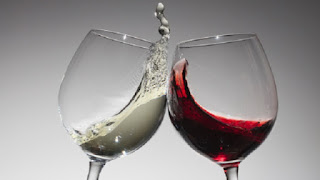The Red and the White Wine's
Truth be told, it is almost impossible to have one select category from which you can include all the wine that is being created today. There exists many different categories that use different criteria to group and differentiate wines from another. Do you want it by color? By sweetness? Or do you want it by region (European wine, South American wine, Australian wine, etc)? The possible classifications are as numerous as the number of wines themselves, so for brevity we will stay with the two main wine categories – red and white – so that you can come out from this post with a working knowledge of wines and wine matching, especially if you are about to plan a meal and want to have wine on the menu.
Red Wine
· Glass – having the proper red wine glass will ensure that the properties of the wine will show through much better than in other glasses. A proper red wine glass has an oval- or egg-shaped bottom that narrows down at the top. It must accommodate around 10-22 ounces of liquid and must leave ample room for you to swirl your wine around the glass, thus exposing it to air (allowing it to “breathe”)
· Serving Temperature – it varies with the actual red wine variety but it is usually between 60-65 degrees F. Warmer than that and you will really taste the alcohol, colder than that and the wine will taste bitter.
· Wine Matching – foods that go with red wine are generally those that have bolder, more rounded flavors. Use the following guide as a general reference:
o Cabernet Sauvignon: duck, spicy beef, pate, rabbit, roasts, spicy poultry, cheddar, blue cheese, sausage, kidneys
o Pinot Noir: braised chicken, cold duck, rabbit, charcuterie, partridge, roasted turkey, roasted beef, lamb, veal, truffles, Gruyeres
o Merlot: braised chicken, cold duck, roasted turkey, roasted beef, lamb, veal, stew, liver, venison, meat casseroles
o Shiraz: braised chicken, chili, goose, meat stew, peppercorn steak, barbequed meat, spicy meats, garlic casserole, ratatouille
White Wine
· Glass – white wine is served in narrower, sometimes taller glasses in order to concentrate the aromas of such delicate white wines at the tapering part of the glass.
· Serving Temperature – typically colder than that of red wine, at around 45-50 degrees F. Of course there are differences depending on which type of white wine, so better consult with experts if you want exact serving temperatures.
· Wine Matching – more delicate flavors, such as those of fish and chicken, are classically the perfect match for white wine. Some varietals are suited to much stronger flavors also and have the body of red wine at times. Be guided by the reference below:
o Chardonnay: seafood with butter sauce, chicken, pasta with cream sauce, veal, turkey, ham, Emmenthal, Gruyeres, Port-Salut
o Riesling: mild cheese, clams, mussels, Asian dishes, sashimi, ham, pork, lobster Newberg, Tandoori chicken, Coquilles St Jacques
o Sauvignon Blanc: oysters, grilled or poached salmon, seafood salad, Irish stew, ham, chevre, goat cheese and strongly flavored cheeses, asparagus quiche
Gewurztraminer: spicy dishes, Thai food, curry, smoked salmon, pork and sauerkraut, Muenster, spiced/peppered cheeses, onion tart

Thanks for sharing us about the truths behind the red wines and white wines. Indeed, it is very important to understand this to make sure that take only what is healthy and useful for and what food matches well in this occasion of drinking.
ReplyDeleteJeff Morgan (Hormone Replacement Therapy)